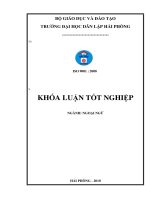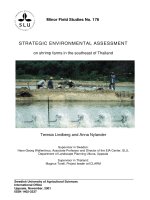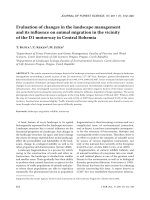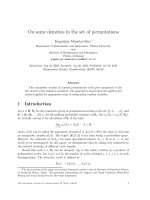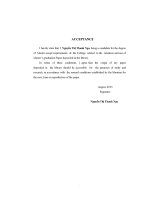STUDY ON PHASE CHANGE IN THE CORE OF NUCLEAR REACTOR
Bạn đang xem bản rút gọn của tài liệu. Xem và tải ngay bản đầy đủ của tài liệu tại đây (1.12 MB, 22 trang )
1. Introduction
Void fraction plays an important role in modeling of two phase flow
at component scale. In CTF code, during solving the conservation
equations, the void fraction is calculated. Then, the flow regime is
defined based on value of void fraction. For example, flow regimes
are determined based on the range of void fraction in normal wall
models as illustrated in Figure 2.8 of this thesis. The normal wall
flow regime map includes the following flow regimes:
Small-bubble defined by void fraction below 0.2
Small-to-large bubble (Slug) defined by void fraction in
range (0.2, 0.5)
Churn/turbulent defined by void fraction in range (0.5 αcrit)
Annular/mist defined by void fraction greater αcrit
Then each of the individual flow regimes of the normal wall map, the
interfacial area, interfacial drag and interfacial heat transfer are
defined differently.
Figure 2.8 CTF normal-wall flow regime maps (source [38])
1.1 Thesis objectives
Void fraction study on flow through a channel with heating wall is
important in thermal hydraulics analysis with a lot of experiments
and codes developments. Thus, based on the material of the national
projects (code DTDL.2011-G/82 and KC.05.26/11-15) it is proposed
a motivation of the study with the objective to predict void fraction
prediction in core of the VVER-1000/V392 nuclear reactor using
1
best estimate approach. The issues are proposed to study as
following:
To adopt a procedure of void fraction prediction during
transient using multi scale analysis based on the computer
codes: MCNP5, RELAP5 and CTF;
To consider a combination of CTF and CFX (Ansys CFX)
codes to improve void fraction predicted by CTF in specific
timing within the transient period.
In the issues mentioned above, the consideration of utilization of
CTF and CFX codes to improve void fraction prediction in core is a
new one. As usually, CTF is used to predict void fraction during
transient time. It is expected that CFX with meso scale for void
fraction prediction will give an improvement to predict for steady
state in specific timing.
1.1.1 Studied object
The void fraction in hot channel of VVER-1000/V392 reactor is
predicted with different scales during 40 seconds of transient
condition at the beginning of LOCAs with different break sizes.
1.1.2 Scope study
It is also limited the scope of the study due to complexity of the two
phase flow. The investigated two phase flow through core sub
channels is vertical flow with the specific regime such as bubbly,
slug, churn and annular.
1.2 Thesis outline
Thus, the thesis includes four chapters and the conclusion at the last.
The chapter 1 mentions about introduction that leads to motivation of
this study with following arguments:
Status of nuclear power in the World and Vietnam
Brief overview of nuclear safety
Core thermal hydraulics safety analysis in transient condition
VVER technologies understanding in Vietnam related to this
study
Thesis objectives
Thesis outline
Chapter 2 presents the methodology that is related to multi scale
analysis along with the code theories at different scale for RELAP5,
2
CTF and CFX with emphasize to phase change models in several
items below:
Multi scale approach to LWR thermal hydraulic simulation
System code RELAP5
Sub channel code CTF
Meso scale code CFX
Conclusions
The verification and assessment of modeling used in these codes in
this study versus experiment data are presented in chapter 3. The
system simulation results are compared with those in SAR
documents (Belene project). The assessment of CTF code is
implemented by simulation BM ENTEK experiment tests which is
an International Standard Benchmark to investigate boiling flow
through Russian fuel bundle of RBMK reactor. The meso scale code
CFX is verified with PSBT single sub channel which is also an
International Standard Benchmark. Therefore the contents of chapter
3 are presented as following:
Brief information of VVER-1000/V392 nuclear reactor
Verification of RELAP5 simulation models for VVER1000/V392 reactor with SAR
Verification and assessment of CTF models with BM
ENTEK experiment tests
Verification CFX models with PSBT sub channel
experiment tests
Conclusions
The tasks related to thesis objectives mentioned in chapter 1 are
solved in chapter 4 with following steps:
Calculation Diagram
Power distribution calculation by MCNP5 code
LOCAs simulation by RELAP5 code
Transient simulation in LOCAs by CTF code
Steady state simulation specific timing of LOCAs by CFX
code
Conclusions
2. Overview of phase change models in code theories with
different scales
The chapter 2 presented following issue:
3
2.1 Multi codes and multi scales approach to PWR thermal hydraulic
simulation
2.1.1 Neutron codes and thermal hydraulics codes
2.1.2 The different scale of thermal hydraulic codes
2.1.3 The different thermal hydraulic modeling approaches
2.2 Phase change models in system code RELAP5
2.3 Phase change models in sub channel code CTF
2.3.1 Evaporation and condensation induced by thermal phase
change
2.3.2 Evaporation and condensation induced by turbulent mixing and
void drift
2.4 Phase change models in meso scale code CFX
2.4.1 Evaporation at the wall
2.4.2 Condensation model in bulk of liquid
2.5 Conclusions
In summary, this chapter shows the detail of multi code and multi
scale for PWR thermal hydraulics simulation, in especially for void
fraction prediction. The phase change of the codes used to predict
void fraction in this thesis including RELAP5, CTF and CFX are
briefly presented.
3. Verification and assessment of phase change models by
numerical simulation
The chapter 3 presents the thesis’ study on verification and
assessment of phase change models by numerical simulation codes
with different scales such as RELAP5 for the whole system of
VVER-1000/V392 reactor, CTF for ENTEK BM experiment and
CFX for PSBT single channel. Then the assessment of CFX and CTF
for void prediction based on PSBT is presented. In briefly
conclusions, the findings and achievements of this chapter are
presented below.
3.1 Verification of RELAP5 simulation models for VVER1000/V392 reactor with SAR
The purpose of this section is verification of RELAP5 modeling
developed by this study for VVER-1000/V392 reactor. Therefore,
simulation results of this study are compared with those in SAR for
LOCAs scenarios. The comparisons focus on steady state results,
4
timing of transient events and behavior of peaking temperature of
cladding.
3.2.2 Verification of modeling through steady-state study
The results show that the steady-state calculations are matched and
acceptable with design values in compare with SAR calculation in
[35] since the deviation between these two values is within 4%.
Table 3.2 Comparison of steady-state of VVER-1000/V392
Parameter
Dim.
Design
value
SAR
results[35]
Reactor thermal power
Reactor outlet pressure
Reactor inlet temperature
Reactor outlet temperature
Pressurizer (PRZ) level
Steam Generator (SG) inlet
pressure - primary side
Total volumetric flow rate at
reactor inlet
SGs wide range level
measurement
Feed water temperature
Maximum fuel temperature
SGs pressure at steam collector
outlet
MW
MPa
o
K
o
K
M
MPa
3000
15.7 ± 3
564.15+2-5
594.15±5
8.17
15.64 ± 0.3
3120
16.0
566.15
599.15
8.17
15.94
The
present
study
3120
15.8
561.8
591.8
8.18
15.75
m3/h
86000+2600
82200
86029
0.03%
M
2.7 ± 0.05
2.65
2.63
2.59%
o
493.15± 5
2078.15
6.27 ± 0.1
498.15
2189.15
6.37
493.15
1843.14
6.27
0.00%
0.84%
0.00%
K
K
MPa
o
Deviation
(Percent)
4.00%
0.64%
0.42%
0.40%
0.12%
0.70%
3.2.3 Verification through accident case study
The comparison results of chronological sequence of the
main events for Event 3 are given in Table 3.4.
Table 3.4 chronological sequence of the Event 3 from SAR [35] and
this study
Time,
s
0.00
SAR results
MCPL guillotine break at the
reactor inlet
And Loss of off-site power
supply:
- startup of DG and safety
systems according to stepwise
startup program (failure of one
DG to start up and one DG is in
repair)
- Trip of the systems for normal
operation;
Time,
s
0.00
The present study
Dev.
MCPL guillotine break at the
reactor inlet
And Loss of off-site power supply:
- startup of DG and safety systems
according to stepwise startup
program (failure of one DG to start
up and one DG is in repair)
- Trip of the systems for normal
operation;
5
0
0.03
0.04
1.90
7.00
17.0
30.0
40.00
60.00
63.00
117.00
500.00
Scram signal generation due to
Pressure above the core is below
14.70 MPa
Set point for connection of ECCS
pumps is reached
SCRAM signal generation
Beginning of injection into the
reactor from HA-1
Opening of valves in the pipelines
connecting HA-2 to the core due
to primary pressure decreases up
to 1.50 MPa
Connection of SG PHRS to SG 1,
2
Beginning of injection from the
ECCS pumps
Bringing of SG 1, 2 PHRS to full
power
Termination of boron solution
injection into the reactor from
HA-1
Beginning of supply from HA-2
End of the calculation
0.08
0.03
1.90
6.00
15.00
30.00
40.00
75.00
63.00
115.00
500.00
Scram signal generation due to
Pressure above the core is below
14.70 MPa
Set point for connection of ECCS
pumps is reached
SCRAM signal generation
Beginning of injection into the
reactor from HA-1
Opening of valves in the pipelines
connecting HA-2 to the core due to
primary pressure decreases up to
1.50 MPa
Connection of SG PHRS to SG 1, 2
0.05
Beginning of injection from the
ECCS pumps
Bringing of SG 1, 2 PHRS to full
power
Termination of boron solution
injection into the reactor from HA-1
0
Beginning of supply from HA-2
End of the calculation
0
1
2
0
15
0
2
0
The comparison of peaking temperature (PCT)
(a)
0.01
(b)
Figure 3.4 (a) Cladding temperature from calculations, (b) Cladding
temperature from SAR
Figure 3.4 also show the study’s calculations are similar to SAR
results in term of peaking cladding temperature and timing to cool
6
down cladding temperature. Therefore, the simulation model of this
study is appropriate with reference model from the SAR.
3.3 Verification and assessment of CTF models with BM ENTEK
tests
Along channel void fraction distribution discussion
Table 3.6 and Table 3.7 show the void fraction distribution
calculation results versus experiment distribution along the channel.
Table 3.8 shows the deviation between void fraction distribution
calculation results versus experiment distribution. It is observed that
CTF’s void fraction distribution predictions for base cases are good
agreement with experiment distribution with mainly deviation
around 0.03 of void. The maximum deviations with value around 0.1
are occurred just one or two locations of the tests T04 and T08.
Especially, for the five tests at 7 MPa (T17, T18, T22, T24 and T25),
the very good void fraction distribution calculations are agreed with
experiment distribution with deviation not more than 0.03 void along
the channel.
Table 3.6 Base case void fraction distribution calculations versus
experiment for cases at 3MPa
Z
0.385
0.948
1.573
2.322
2.947
4.01
4.823
5.448
6.135
6.76
T01x
0
0
0
0
0
0
0.027
0.178
0.493
0.635
T01c
0
0
0
0
0
0
0.003
0.155
0.591
0.706
T04x
0
0.006
0.015
0
0.002
0.002
0.043
0.136
0.299
0.472
T04c
0
0
0
0
0
0
0.022
0.157
0.459
0.584
T08x
0.003
0.01
0.001
0
0
0.206
0.621
0.756
0.83
0.86
T08c
0
0
0
0
0
0.088
0.574
0.759
0.842
0.877
T10x
0
0.001
0.006
0
0.006
0.165
0.398
0.541
0.652
0.74
T10c
0
0
0
0
0
0.067
0.342
0.608
0.723
0.771
T14x
0.002
0.001
0
0
0
0.24
0.484
0.594
0.646
0.718
T14c
0
0
0
0
0
0.183
0.441
0.588
0.673
0.714
(x = Experiment, c= Calculation)
Table 3.7 Base case void fraction distribution calculations versus
experiment for cases at 7MPa.
Z
0.385
0.948
1.573
2.322
2.947
4.01
4.823
T17x
0
0.004
0.006
0
0.009
0.002
0.017
T17c
0
0
0
0
0
0
0
T18x
0
0.003
0
0.009
0.089
0.275
0.405
T18c
0
0
0
0
0.005
0.179
0.381
T22x
0.001
0.018
0.015
0.085
0.22
0.446
0.579
T22c
0
0
0
0.03
0.134
0.496
0.616
T24x
0
0
0
0
0
0.1027
0.2814
T24c
0
0
0
0
0
0.076
0.25
T25x
T25c
0
0
0
0
0
0
0.1548
7
0
0
0
0
0
0.001
0.123
5.448
6.135
6.76
0.033
0.079
0.194
0
0.056
0.17
0.485
0.553
0.612
0.503
0.585
0.628
0.654
0.733
0.79
0.694
0.75
0.781
0.3973
0.4834
0.5585
0.406
0.512
0.564
0.4021
0.5178
0.6398
0.364
0.591
0.67
Table 3.8 Deviation between void fraction distribution calculation results
versus experiment
Z
D(T01)*
Heat
mode
D(T04)
Heat
mode
D(T08)
Heat
mode
D(T10)
Heat
mode
D(T14)
Heat
mode
0.385
0
spl
0
spl
-0.003
spl
0
spl
-0.002
spl
0.948
0
spl
-0.006
spl
-0.01
spl
-0.001
spl
-0.001
spl
1.573
0
spl
-0.015
spl
-0.001
spl
-0.006
spl
0
spl
2.322
0
spl
0
spl
0
spl
0
spl
0
subc
2.947
0
spl
-0.002
spl
0
spl
-0.006
spl
0
subc
4.01
0
spl
-0.002
subc
-0.118
subc
-0.098
subc
-0.057
nucb
4.823
-0.024
subc
-0.021
subc
-0.047
nucb
-0.056
nucb
-0.043
nucb
5.448
-0.023
subc
0.021
nucb
0.003
nucb
0.067
nucb
-0.006
nucb
6.135
0.098
nucb
0.16
nucb
0.012
nucb
0.071
nucb
0.027
nucb
6.76
0.071
nucb
0.112
nucb
0.017
nucb
0.031
nucb
-0.004
nucb
D(T017)
Heat
mode
D(T18)
Heat
mode
D(T22)
Heat
mode
D(T24)
D(T25)
Heat
mode
Z
Heat
mode
0.385
0
spl
0
spl
-0.001
spl
0
spl
0
spl
0.948
-0.004
spl
-0.003
spl
-0.018
spl
0
spl
0
spl
1.573
-0.006
spl
0
spl
-0.015
subc
0
spl
0
spl
2.322
0
spl
-0.009
subc
-0.055
subc
0
subc
0
spl
2.947
-0.009
spl
-0.084
subc
-0.086
nucb
0
subc
0
spl
4.01
-0.002
0.05
nucb
nucb
0.001
subc
4.823
-0.017
0.037
nucb
5.448
-0.033
0.04
nucb
0.0087
nucb
6.135
-0.023
subc
0.032
nucb
0.017
nucb
0.0286
nucb
0.0732
nucb
6.76
-0.024
nucb
0.016
nucb
-0.009
nucb
0.0055
nucb
0.0302
nucb
spl
subc
subc
-0.096
-0.024
0.018
nucb
nucb
nucb
0.0267
0.0314
nucb
0.0318
0.0381
D (T01) = (T01C-T01X), c = calculation, x = experiment
8
subc
nucb
It is found that CTF tend to under prediction when experiment void
fraction below 0.2 where the CTF’s modeling for normal wall flow
regime map is small bubble. At the nearly outlet of the channel
where the experiment data are more above 0.2 corresponding to heat
transfer in saturated mode, CTF tend to over prediction. Thus, CTF
boiling model is still needed to be improved for both sub cooled and
nucleate boiling regimes in order to generate more void in sub cooled
region and reduce void at nucleate boiling region.
3.4 Verification CFX models with PSBT sub channel tests
3.4.6 Assessment of CFX and CTF modeling results in comparison
with PSBT single channel
It is clear that CFX give better void fraction prediction in small
bubble flow regime corresponding with sub cooled heat transfer
mode in CTF. It is noticed that the Nusselt number correlation used
in CFX models for this case is Ranz Marshall.
Table 3.24 CFX and CTF results comparisons versus experiment
void fraction in small bubble and sub cooled region
Run
No
Pressure
(kg/cm2)
Mass Flux
(106kg/m2h)
Power
(kW)
Inlet
Temp.
(oC)
Exp.
Void
CFX
CTF
heat
Mode
1.2231
150.2
10.87
60.0
299.3
0.013
0.012
0.001
subc
1.2211
150.1
10.91
90.0
295.4
0.038
0.075
0.074
subc
1.4321
100.5
5.01
59.9
209.3
0.045
0.008
0.005
subc
1.4323
100.5
5.03
59.9
229.2
0.047
0.062
0.085
subc
1.5221
75.5
5.02
49.9
219.2
0.047
0.062
0.086
subc
1.2221
150.1
10.88
69.8
299.4
0.048
0.039
0.004
subc
1.2421
150.2
5.02
59.8
268.9
0.053
0.072
0.047
subc
1.3221
125.0
11.10
59.9
294.4
0.053
0.085
0.054
subc
1.2233
150.2
10.89
59.9
309.6
0.060
0.078
0.025
subc
1.2121
150.1
14.80
79.9
309.5
0.063
0.075
0.028
subc
1.6221
50.5
5.01
50.0
189.2
0.075
0.049
0.103
subc
1.2212
150.1
10.88
90.0
299.4
0.079
0.103
0.109
subc
1.2234
150.1
10.92
60.1
314.6
0.080
0.125
0.077
subc
D(CFX)*
D(CTF)
-0.001
-0.012
0.037
0.036
-0.037
-0.040
0.015
0.038
0.015
0.039
-0.009
-0.044
0.019
-0.006
0.032
0.001
0.018
-0.035
0.012
-0.035
-0.026
0.028
0.024
0.030
0.045
-0.003
9
1.1221
169.1
10.95
49.9
329.7
0.087
0.109
0.032
subc
1.4121
100.1
10.97
69.9
274.1
0.097
0.118
0.134
subc
1.1222
169.1
10.98
50.0
334.7
0.142
0.168
0.094
subc
1.4411
100.4
1.99
19.9
253.7
0.152
0.183
0.167
subc
1.4324
100.1
5.02
60.1
238.9
0.157
0.145
0.197
subc
1.2422
150.1
5.00
60.0
284.1
0.182
0.194
0.198
subc
0.022
-0.055
0.021
0.037
0.026
-0.048
0.031
0.015
-0.012
0.040
0.012
0.016
Table 3.25 shows the void fraction calculations by CTF and CFX
versus experiment in saturated region with measured void fraction in
range of small-to-large bubbles and pressure lower than 122 bar. It is
observed that CTF give the over prediction in this region while CFX
give the under prediction. It is noticed that Nusselt number
correlation used in CFX models in this case is Warierr.
Table 3.25 Comparison of CFX and CTF results and experiment void
fraction in saturated region
Run
No
Pressure
(kg/cm2)
Mass Flux
(106kg/m2h)
Power
(kW)
Inlet
Temp.
(oC)
Exp.
Void
CFX
CTF
heat
Mode
D(CFX)*
D(CTF)
1.5222
75.0
5.00
50.0
243.9
0.411
0.429
0.452
nucb
0.018
0.041
1.4412
100.2
5.03
79.8
248.9
0.504
0.605
0.584
nucb
0.101
0.080
1.4326
100.1
5.02
60.1
268.8
0.531
0.483
0.555
nucb
-0.048
0.024
1.4312
100.2
5.03
79.8
248.9
0.566
0.457
0.588
nucb
-0.109
0.022
1.4122
99.8
10.90
69.8
304.5
0.636
0.388
0.592
nucb
-0.248
-0.044
1.5223
75.6
5.03
49.9
263.8
0.647
0.568
0.637
nucb
-0.079
-0.010
1.6312
50.6
1.96
20.1
238.9
0.680
0.763
0.716
nucb
0.083
0.036
1.4327
100.1
4.96
59.9
289.0
0.688
0.591
0.689
nucb
-0.097
0.001
1.6212
50.4
5.00
79.8
199.3
0.711
0.529
0.717
nucb
-0.182
0.006
1.6223
50.5
5.03
49.9
239.0
0.718
0.609
0.72
nucb
-0.109
0.002
3.4.8 Improvement of CFX void fraction prediction in saturated
region
Table 3.28 shows the void fraction and temperature superheating
calculated before and after calibration presented in columns “Void”,
“Tsup” and “Void*”, “Tsup*”, respectively. It is noticed that Nusselt
number correlation used in CFX models in this case is Kim and Park.
10
Table 3.28 Void fraction and temperature super heating before and
after calibration
Run
Void
Tsup
Scaling
43.28
Exp.
Void
0.531
DeltaT
* (K)
1.2
Void*
1.4
MA
F
0.65
1.4326
0.428
1.4312
D(CFX)
D(CFX)*
0.544
Tsup*
(K)
28.5
-0.103
0.013
0.404
62.57
0.566
1.4
0.75
2.4
0.559
48.66
-0.163
-0.007
1.4122
0.411
37.23
0.636
1.4
0.9
2.9
0.584
21.51
-0.226
-0.052
1.5223
1.4327
0.526
39.21
0.647
0.567
43.49
0.688
1.4
0.6
3.0
0.638
19.95
-0.121
-0.009
1.4
0.8
1.0
0.721
17.76
-0.121
0.033
1.6223
0.714
35.21
0.718
1.4
0.82
3.2
0.737
27.97
-0.004
0.019
*D (CFX) = (Void – Exp. Void), D (CFX) = (Void* - Exp. Void)
Conclusions
It is summarized the overall conclusions for verification and
assessment of phase change as following.
- The system code RELAP5 with capability of modeling of whole
system related to heat removal from the core to ultimate heat sink is
utilized to simulate the reactor VVER-1000/V392 and related
systems. With the purpose of verification of our RELAP5 modeling,
a scenario of LBLOCA in the confident document, Safety Analysis
Report (SAR) for Belene (Bulgaria) project is used to compare
simulations results. Based on the two following arguments: (a) the
deviations of timing in chronological sequence of main events in
Table 3.4 with maximum of 15 seconds; (b) the behavior of
maximum of peak cladding temperature (PCT) in the first duration of
300 seconds with similar maximum values less than 1200 oC and
timing of cool down around at 280 seconds as illustrated in Figure
3.4, it is shown that simulation results given by this study are good
agreed with the results presented in SAR.
- With regard to void fraction prediction in the core, the system code
RELAP5 is not confident tool in case of high equivalent diameter of
channel. This conclusion is exposed from two issues: (a) RELAP5 is
1D code, so that the average or hot channel in the core is simulated
as a pipe, that means the geometry of the core is not simulated as
reality and the flow regime map in modeling may be different from
11
the reality; (b) The phase change models at the wall as presented in
formulas (2.6) and (2.7) are depended on temperature near wall.
- CTF boiling models tend to under predict void fraction in sub
cooled region where void fraction below 0.2 and tend to over predict
void fraction at nucleate boiling region where void fraction above
0.2. For BM ENTEK experiment, CTF give void fraction distribution
predictions for most all base cases are good agreement with
experiment distributions with mainly deviation within experiment
measured accuracy for void fraction (0.03 of void) and the maximum
deviations with 0.1 of void between CTF prediction and experiment
occur at downstream of channel in some tests.
- CFX gives the good prediction when void fraction below 0.2,
corresponding with sub cooled heat transfer mode in CTF, with
deviations around 0.03 of void. So that, results in sub cooled region
it is recommended to use void fraction predicted by CFX instead of
CTF.
- For the saturated region corresponding with small-to-large bubble
flow regime, CTF tends to give over void prediction and CFX tends
to give under void prediction, Then, it is considered CFX and CTF
results as lower and upper bounds for void fraction prediction along
the channel.
- The improvement CFX simulation results in saturated region by
scaling bubble departure diameter and maximum area fraction for
quenching effect brings a new approach to continue development of
RPI boiling models for saturated region.
4. Void fraction prediction in hot channel of VVER-1000/V392
4.2 Power distribution calculation by MCNP5 code
The calculation results are based on whole core geometry simulation
and the number of neutron histories equal 2.107 (with relative
variation for keff around 10-5). The relative power for each assembly
in 1/6 of the core is presented in Figure 4.5. Thus, the hot channel is
an assembly with identification of 30A9P corresponding to
maximum relative factor of 1.72. This value of power distribution is
appropriate because it is within the range of (1.6, 1.8) mentioned in
[34].
12
Figure 4.5 The relative power distribution in the sixth of the whole
core
Figure 4.6 shows the axial channel distribution of relative power
with the maximum peaking factor of 1.52 that is also appropriate
with distribution for the first fuel cycle as mentioned in [34].
Figure 4.6 Distribution of relative power along axial hot channel
For the CTF heat flux modeling, it is also needed the distribution of
power inside each rod of hot channel and this calculation results are
also performed by MCNP5. Figure 4.7 shows the relative power
distribution for each rod inside the hot channel with maximum
peaking factor of 1.374.
13
Figure 4.7 Distribution of relative power in the hot channel
4.4.1 VVER-1000/V392 void fraction prediction by RELAP5 and
CTF
Table 4.2 Case studies for void fraction prediction
Case ID
Description
LB01001
LB01002
SB01003
SB01004
Large break LOCA coupled with SBO-1
Large break LOCA coupled with SBO-2
Small break LOCA coupled with SBO-1
Small break LOCA coupled with SBO-2
Break
Area
(m2)
0.11
0.095
0.07
0.05
Equivalent
Diameter (m)
Location
of break
0.374
0.348
0.298
0.252
Cold Leg
Cold Leg
Cold Leg
Cold Leg
14
(LB01001)
(LB01002)
(SB01003)
(SB01004)
Figure 4.13 Void fraction prediction by CTF and RELAP5 for
SBLOCAs
Accuracy of void faction predictions
- Geometry of flow in modeling
Due to RELAP5 model of flow is 1D, so that the flow through hot
channel including 312 fuel rods is simulated as the flow in a pipe
with equivalent flow area of 0.02538 m2 as mentioned in Table 28.
The conversion of geometry of flow in RELAP5 causes inaccuracy
in flow regime in comparison with origin flow. This issue affects to
accuracy of void fraction. In other hand CTF model of flow is 3D as
illustrated in Figure 4.2 with P equal 12.75 mm and D equal 9.1 mm.
Therefore, the flow at scale of sub channel is modeled properly.
- Determine temperature of liquid near wall
For the RELAP5 model, the temperature is averaging inside a control
volume. Therefore, the temperature of liquid near wall is the same at
the center of the flow. For example, with the flow area of 0.02538
m2 then the distance from center of flow to the wall is around 9 cm.
For the CTF model of flow is based on sub channel geometry as in
Figure 4.2, and then the distance from the center of flow to the wall
is about 0.275 cm.
It is concluded that the physical models for phase change of
RELAP5 and CTF presented in formulas (2.6), (2.7) and (2.8),
(2.17), respectively, is depended on near wall liquid enthalpy (or
temperature). CTF gives the near wall enthalpy better than RELAP5,
15
and then its calculation of phase change is more accuracy. Besides,
the conversion of flow is not implemented as in RELAP5, so that, the
flow regime in CTF model is reliable.
Based on above arguments and the fact that CTF can predict void
fraction with pressure of 3MPa and 7MPa with acceptable accuracy
such as BM ENTEK tests [33], it is concluded that CTF gives better
void fraction prediction results than RELAP5.
4.5 Void fraction prediction of single channel by CFX code
For the case identification such as SB01003-09-37, it is shown that
this case is taken from case identification as in Table 4.2 (SB01003)
with the timing of view at 09 second from beginning of transient and
sub channel number of 37 as in Figure 4.11
Figure 4.11 the cross section of CTF modeling for the selected part of the
whole bundle
Based on conclusion in chapter 3, it is recommended that for the case
that CTF give void fractions lower than 0.2, it is used CFX results
instead of CTF. For the saturated region with small-to-large bubble
regime, it is considered that CTF and CFX results are considered as
upper and lower bounds, respectively.
Table 4.7 Void fraction prediction by CTF and CFX at downstream
of channel at z = 3.48m
Case ID
SB01003-16-15
CTF bundle
0.062
CTF Boiling Mode
nucb
CTF single
0.094
CFX
0.1319
16
SB01003-16-30
SB01003-14-34
SB01003-20-15
LB01002-20-18
LB01002-15-30
LB01002-20-20
SB01003-09-37
LB01002-30-30
0.146
0.173
0.153
0.424
0.395
0.442
0.429
0.609
nucb
nucb
nucb
nucb
nucb
nucb
nucb
nucb
0.101
0.152
0.2
0.356
0.361
0.438
0.444
0.64
0.1371
0.1964
0.2195
0.2979
0.32
0.3954
0.4064
0.6433
Figure 4.18 Axial sub channel void fraction prediction by CFX and CTF
4.6 Void fraction prediction for a bundle of channel by CFX code
As conclusions in section 3.5 chapter 3, the results of CTF in small
bubble flow corresponding with heat transfer mode of sub cooled
region are recommended to be replaced by CFX results and for
saturated region CTF and CFX predictions are considered as lower
and upper bound curves. Therefore, to illustrate this argument, it is
selected sub cooled and saturated domains for each case as presented
in Table 4.8 and 4.9, respectively.
17
Table 4.8 Sub cooled selected regions for CFX investigation
Sub cooled selected region
Inlet
(m)
Outlet
(m)
Inlet
void
0.0
Inlet
Pressure
(bar)
101.712
Mass
flow
(kg/s)
3.86
LB01001-06
0.926
1.647
LB01002-07
1.236
SB01003-14
SB01004-30
Power
(kW)
438.944
Inlet
temp
(oC)
300.486
1.956
0.0
106.812
4.94
416.674
301.539
2.265
2.986
0.018
89.841
3.9
94.057
300.396
1.544
2.265
0.0
75.489
2.64
52.142
287.685
Table 4.9 Saturated selected regions for CFX investigation
Saturated selected region
Inlet
(m)
Outlet
(m)
Inlet
void
0.707
Inlet
Pressure
(bar)
101.168
Mass
flow
(kg/s)
3.89
LB01001-06
3.089
3.53
LB01002-07
3.089
SB01003-14
SB01004-30
Power
(kW)
95.701
Inlet
temp
(oC)
311.852
3.53
0.467
106.215
4.92
77.111
315.459
3.089
3.53
0.1
89.708
3.89
21.658
303.952
3.089
3.53
0.129
75.302
2.69
11.833
290.812
The left pictures of Figure 4.21 present CTF’ void fraction prediction
and improvement results by CFX calculation for cases LB01001-06,
LB01002-07, SB01003-14 and SB01004-30. The right pictures of
Figure 4.21 show the upper and lower bounds for void fraction given
by CTF and CFX calculation results. It is noticed that CTF give
higher prediction than CFX as mentioned in sections 3.4 and 3.5 in
chapter 3.
18
Figure 4.21 Improvement by CFX in left pictures and upper and
lower bounds in right pictures
4.7 Conclusions
19
In summary of the work done in this chapter, several of the main
issues from study of void fraction prediction for hot channel in the
core of VVER-1000/V392 are presented as below.
- It is well implemented the simulation of VVER-V392 reactor by
system code RELAP5 with power distribution provided by neutron
code MNCP5 for the first fuel cycle using the model which is
validated as mentioned in chapter 3.
- CTF and CFX can be used to predict void fraction in the core based
on reference to each other. With the void fraction below 0.2 and heat
transfer mode in CTF is sub cooled boing, CTF tends to give under
prediction and in this case it is used CFX results instead of CTF due
to CFX gives better prediction with accuracy around ±0.03 of void.
- Due to CTF tends to over prediction of void fraction in nucleate
boiling mode. So that, in saturated boiling region, CTF and CFX
void fraction predictions can be used as upper bound and lower
bound curves.
5. Conclusions
As mentioned in chapter 1, the main objective of the thesis is
numerical investigation of void fraction in the core of VVER1000/V392 reactor with the goal as following:
To adopt a procedure of void fraction prediction during
transient using multi scale analysis based on the computer
codes: MCNP5, RELAP5 and CTF;
To consider a combination of CTF and Ansys CFX codes to
improve void fraction predicted by CTF in specific timing
within the transient period.
It is concluded that both above issues are solved in this study. The
procedure of void fraction prediction during transient using multi
scale are presented in chapter 4 based on verification and validation
of boiling models for different scale codes which is implemented in
chapter 3.
As mentioned in chapter 1, a utilization of CTF and CFX codes to
improve void fraction predicted CTF is new issue for void fraction
prediction in the core. As results of the thesis, the issue of void
fraction prediction in core is improved by the utilization of CTF and
CFX codes with reference to each other. CTF give the void
prediction during transient time and its results in specific moment is
20
improved by reference with CFX. In the sub cooled region with low
void (void below 0.2 defined by CTF) the CFX result is used and in
the saturated boiling region (defined by CTF with void normally
between 0.2 and 0.5) then void fraction prediction curves calculated
by CTF and CFX is considered as upper and lower bounds. It is
summarized the thesis results as below.
5.1 New findings and achievements from the thesis
Proposal of a reality of best estimate approach in void fraction
prediction by utilization of multi codes and multi scale including
MCNP5, RELAP5, CTF and CFX for analysis of void fraction
behavior in the core during transient.
For system analysis by RELAP5 code for VVER-1000/V392, it
is found that temperature near heated wall is not defined with
enough accuracy if simulation of a whole fuel assembly as hot
channel, so that the phase change models in RELAP5 do not give
appropriate value of void fraction.
From verification and validation of CTF results with ENTEK
BM experiment, it is observed that CTF tends to give under
prediction of void in the region of sub cooled boiling and flow
regime in small bubble (αg < 0.2) and CTF tends to give over
prediction of void in nucleate boiling region, corresponding with
small-to-large bubble in flow regime.
From verification with PSBT single sub channel experiment,
CFX with models setup proposed by this thesis is converged
with RMS of 1e-6 and stabilized in term of average void fraction
prediction with physical sensitivity study. For the sub cooled
boiling region corresponding with small bubble of flow regime
(αg < 0.2), CFX gives the appropriate void fraction prediction
with accuracy around ±0.03 of void.
In saturated boiling region, the wall boiling model built in CFX
is incorrectly partitioned heat flux to corresponding parts in
convective, quenching and evaporative. This issue causes CFX
gives under prediction of void fraction in saturated boiling
region. It is proposed a calibration for bubble departure diameter
and maximum area fraction to improve void fraction prediction
by CFX in saturated region.
21
It is established a procedure of utilization of CTF and CFX for
void fraction prediction as following: (a) at sub cooled region,
corresponding with small bubble flow regime, CFX results is
used; (b) in saturated boiling region, CTF and CFX void fraction
curves along the channel is used as upper bound and lower
bound to predict void fraction in the core.
5.2 Proposal of future work
Utilization of CFD codes for investigation of void fraction in the
core is still a challenge. This comes from complexity of boiling
phenomena and the lack of experiment with similar PWR condition
to verification and validation CFD models. Based on study in the
thesis, several following issues are proposed to study.
Study on modification of RPI wall boiling model built in CFX
(and FLUENT) in saturated boiling region. Due to the fact that,
in saturated boiling model, liquid temperature is the same
saturated one everywhere, even near wall, so that evaporation
and quenching phenomena can be dominated.
Implement more experiment in similar PWR conditions which
provides with void fraction distribution that can be used to
validate evaporation and condensation models in CFX
Study on more accuracy of void fraction prediction of CFX
based on condensation models such as the correlation of Nusselt
number in different boiling conditions.
22


